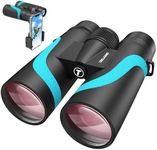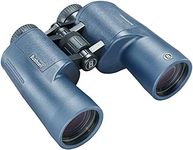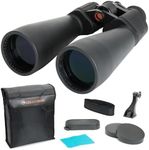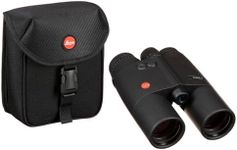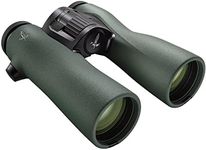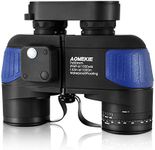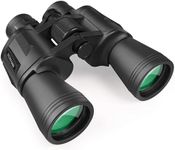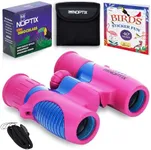Buying Guide for the Best Astronomy Binoculars For Adults
Choosing the right astronomy binoculars can greatly enhance your stargazing experience. Binoculars are a great tool for beginners and experienced astronomers alike, offering a wide field of view and ease of use. When selecting binoculars for astronomy, it's important to consider several key specifications to ensure you get the best fit for your needs. Here are the main specs to look at and how to navigate them.MagnificationMagnification refers to how much closer the binoculars can make objects appear. For astronomy, higher magnification can help you see more details of celestial objects. Binoculars typically range from 7x to 20x magnification. Lower magnification (7x-10x) is easier to handle and provides a wider field of view, which is great for scanning the night sky. Higher magnification (15x-20x) offers more detail but can be harder to stabilize without a tripod. Choose lower magnification if you prefer handheld use and wider views, and higher magnification if you want to see more detail and are okay with using a tripod.
Objective Lens DiameterThe objective lens diameter is the size of the front lenses, measured in millimeters. Larger diameters allow more light to enter, which is crucial for viewing faint stars and galaxies. Binoculars for astronomy typically have objective lenses ranging from 50mm to 100mm. Smaller diameters (50mm-70mm) are lighter and more portable, while larger diameters (80mm-100mm) provide brighter images but are heavier. If you plan to carry your binoculars around or use them for extended periods, smaller diameters might be more comfortable. For stationary use or maximum light gathering, go for larger diameters.
Field of ViewField of view indicates the width of the area visible through the binoculars, usually measured in degrees or feet at a specific distance. A wider field of view allows you to see more of the sky at once, which is helpful for locating and tracking celestial objects. Binoculars with a field of view of 5-7 degrees are common for astronomy. If you enjoy scanning large areas of the sky or tracking moving objects like satellites, a wider field of view is beneficial. For focusing on specific objects, a narrower field of view can be sufficient.
Exit PupilThe exit pupil is the diameter of the light beam that exits the eyepiece, calculated by dividing the objective lens diameter by the magnification. It determines how much light reaches your eyes and affects image brightness. For astronomy, an exit pupil of 5-7mm is ideal, as it matches the dilation of the human eye in dark conditions. Larger exit pupils provide brighter images, which is important for night viewing. If you plan to use your binoculars primarily at night, aim for a larger exit pupil. For daytime use or if you have smaller pupils, a smaller exit pupil can be sufficient.
Prism TypeBinoculars use prisms to correct the orientation of the image. The two main types are Porro prisms and roof prisms. Porro prisms are generally preferred for astronomy because they offer better depth perception and a wider field of view. Roof prisms are more compact and durable but can be more expensive. If you prioritize image quality and a wider field of view, Porro prisms are a good choice. If you need something more compact and rugged, roof prisms might be better.
CoatingsLens coatings improve light transmission and reduce reflections, enhancing image brightness and clarity. Fully multi-coated lenses are ideal for astronomy, as they provide the best light transmission. Look for binoculars with terms like 'fully multi-coated' or 'multi-coated' to ensure good image quality. If you want the brightest and clearest images, opt for fully multi-coated lenses. For casual use, basic coatings can still provide decent image quality.
Weight and SizeThe weight and size of binoculars can affect comfort and ease of use, especially during extended viewing sessions. Larger binoculars with bigger objective lenses tend to be heavier. If you plan to use your binoculars for long periods or carry them around, consider lighter and more compact models. For stationary use or if you don't mind the extra weight, larger binoculars can provide better image quality.
